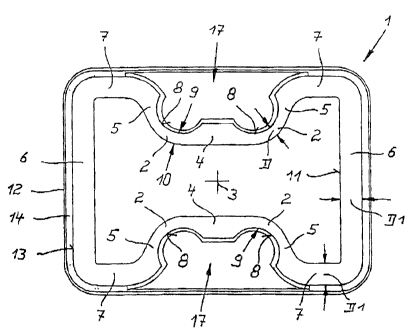Some of the information on this Web page has been provided by external sources. The Government of Canada is not responsible for the accuracy, reliability or currency of the information supplied by external sources. Users wishing to rely upon this information should consult directly with the source of the information. Content provided by external sources is not subject to official languages, privacy and accessibility requirements.
Any discrepancies in the text and image of the Claims and Abstract are due to differing posting times. Text of the Claims and Abstract are posted:
| (12) Patent: | (11) CA 2415517 |
|---|---|
| (54) English Title: | CHILL TUBE |
| (54) French Title: | TUBE REFROIDISSEUR |
| Status: | Granted |
| (51) International Patent Classification (IPC): |
|
|---|---|
| (72) Inventors : |
|
| (73) Owners : |
|
| (71) Applicants : |
|
| (74) Agent: | |
| (74) Associate agent: | |
| (45) Issued: | 2010-02-23 |
| (22) Filed Date: | 2003-01-03 |
| (41) Open to Public Inspection: | 2003-07-31 |
| Examination requested: | 2007-10-25 |
| Availability of licence: | N/A |
| (25) Language of filing: | English |
| Patent Cooperation Treaty (PCT): | No |
|---|
| (30) Application Priority Data: | ||||||
|---|---|---|---|---|---|---|
|
A chill tube having a double T-shaped inner and outer cross-section in beam blank format is encased in a water-guiding jacket adapted to its outer contour while forming a water gap. The wall thickness of the chill tube in the rounded transition regions from middle crosspieces, which face each other head to head and are drawn in towards the longitudinal axis, to the neighboring crosswise positioned flanges is dimensioned at least partially smaller than in the remaining wall sections. The reduction in wall thickness is implemented by longitudinal hollow recesses. These recesses extend only in the height range of the bath level. Into the cross-sectional regions which are formed by the outer contour of chill tube as well as the inner contour of the water-guiding jacket, filler pieces are incorporated, which are adapted to this cross-section.
Un tube refroidisseur doté d'une double section transversale interne et externe en T dans un format de découpé de poutre est placé dans une enveloppe de guidage d'eau adapté à son contour externe, tout en formant un écran d'eau. L'épaisseur de la paroi du tube refroidisseur dans les zones de transition arrondies des pièces transversales intermédiaires, disposées en vis-à-vis et inclinées selon l'axe longitudinal, par rapport aux rebords avoisinants positionnés de façon transversale est au moins partiellement inférieure à celle des autres sections de la paroi. La réduction de l'épaisseur de la paroi est assurée par des fraisures creuses longitudinales. Ces fraisures s'étendent seulement sur le plan de la hauteur du niveau de bain. Dans les zones en section transversale qui sont formées par le contour externe du tube refroidisseur ainsi que le contour interne de l'enveloppe de guidage d'eau, on place des pièces de remplissage qui sont adaptées à cette section transversale.
Note: Claims are shown in the official language in which they were submitted.
Note: Descriptions are shown in the official language in which they were submitted.

For a clearer understanding of the status of the application/patent presented on this page, the site Disclaimer , as well as the definitions for Patent , Administrative Status , Maintenance Fee and Payment History should be consulted.
| Title | Date |
|---|---|
| Forecasted Issue Date | 2010-02-23 |
| (22) Filed | 2003-01-03 |
| (41) Open to Public Inspection | 2003-07-31 |
| Examination Requested | 2007-10-25 |
| (45) Issued | 2010-02-23 |
There is no abandonment history.
Last Payment of $450.00 was received on 2020-12-21
Upcoming maintenance fee amounts
| Description | Date | Amount |
|---|---|---|
| Next Payment if small entity fee | 2022-01-04 | $253.00 |
| Next Payment if standard fee | 2022-01-04 | $624.00 |
Note : If the full payment has not been received on or before the date indicated, a further fee may be required which may be one of the following
Patent fees are adjusted on the 1st of January every year. The amounts above are the current amounts if received by December 31 of the current year.
Please refer to the CIPO
Patent Fees
web page to see all current fee amounts.
Note: Records showing the ownership history in alphabetical order.
| Current Owners on Record |
|---|
| KME GERMANY GMBH & CO. KG |
| Past Owners on Record |
|---|
| EICHHOLZ-BOLDT, RAIMUND |
| HAURI, ROLAND |
| HUGENSCHUTT, GERHARD |
| KM EUROPA METAL AG |
| KME GERMANY AG |
| KME GERMANY AG & CO. KG |
| KOLBECK, DIETMAR |